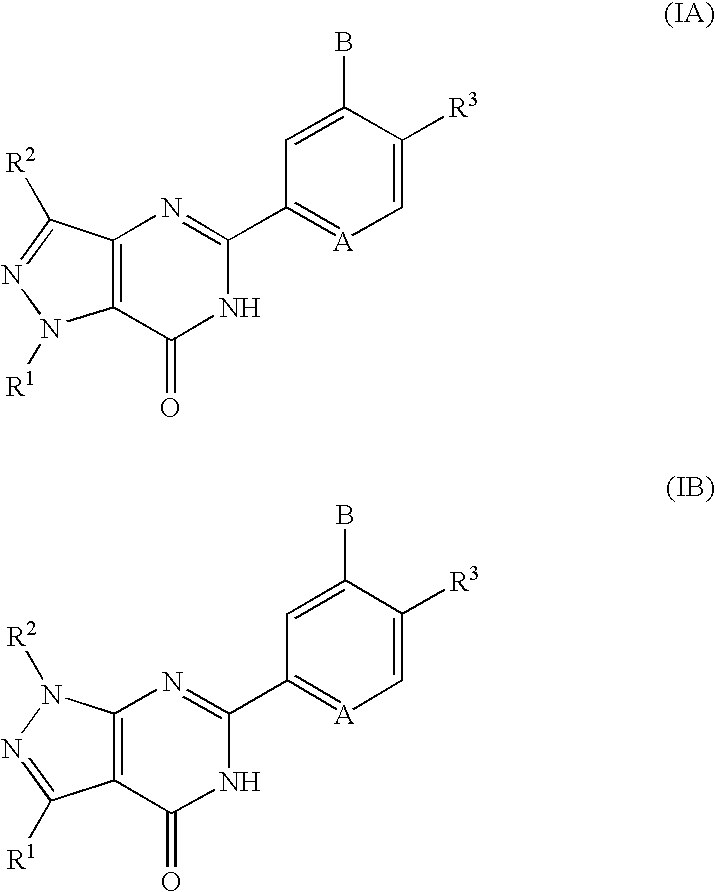Pyrazolopyrimidinone derivatives having PDE7 inhibiting action
a technology of pyrimidinone and derivatives, which is applied in the field of pyrazolopyrimidinone derivatives, can solve the problems of weak inhibition activity, low selectivity for other pde's, and insufficient practical utility of these compounds as ped7 inhibitors, so as to inhibit the activation of t cells and increase the intracellular camp level
- Summary
- Abstract
- Description
- Claims
- Application Information
AI Technical Summary
Benefits of technology
Problems solved by technology
Method used
Image
Examples
production example 1
2-Cyclohexyl-5-methyl-2,4-dihydro-3H-pyrazol-3-one
[0109] A mixture of 14.5 ml (0.134 mol) of methyl acetoacetate and 20.2 g (0.134 mol) of cyclohexylhydrazine hydrochloride was stirred at 120° C. for 2 hours, and then cooled. The reaction mixture was neutralized with 30 ml of a 4M aqueous solution of sodium hydroxide, and extracted with ethyl acetate. The organic layer was washed with water and a saturated aqueous solution of sodium chloride, dried over anhydrous sodium sulfate, and distilled under reduced pressure to remove the solvent. Hexane was added to the residue, and precipitated crystals were collected by filtration to obtain 19.0 g (79%) of the captioned compound.
production example 2
5-Chloro-1-cyclohexyl-3-methyl-4-nitro-1H-pyrazole
[0110] To 9.3 g (51.6 mmol) of the compound obtained in Production Example 1, 10 ml (107 mmol) of phosphorus oxychloride was added, and the mixture was stirred for 10 hours at 120° C. Then, the reaction mixture was brought to room temperature, and the excess phosphorus oxychloride was distilled off under reduced pressure. The residue was dissolved by addition of 45 ml of acetic anhydride and, to this solution, 9 ml of fuming nitric acid was slowly added dropwise with cooling with ice. After the mixture was stirred for 2 hours at the same temperature, the reaction mixture was poured over ice, and solids were collected by filtration. The solids were dissolved in dichloromethane, and the solution was washed with an aqueous solution of sodium hydrogen carbonate, water, and a saturated aqueous solution of sodium chloride. Then, the washed solution was dried over anhydrous sodium sulfate, and the solvent was distilled off under reduced pr...
production example 3
1-Cyclohexyl-3-methyl-4-nitro-1H-pyrazole-5-carbonitrile
[0111] To a 90 ml N,N-dimethylformamide solution of 10.3 g (42.4 mmol) of the compound obtained in Production Example 2, 4.2 g (84.9 mmol) of sodium cyanide was added, followed by stirring the mixture for 1.5 hours at 80° C. Then, the reaction mixture was brought to room temperature, water was added thereto, and the mixture was extracted with dichloromethane. The organic layer was washed with water and a saturated aqueous solution of sodium chloride. Then, the washed solution was dried over anhydrous sodium sulfate, and the solvent was distilled off under reduced pressure. The residue was purified by silica gel column chromatography (hexane / ethyl acetate=6 / 1) to obtain 9.18 g (93%) of the captioned compound.
PUM
| Property | Measurement | Unit |
|---|---|---|
| Mass | aaaaa | aaaaa |
| Mass | aaaaa | aaaaa |
| Mass | aaaaa | aaaaa |
Abstract
Description
Claims
Application Information
 Login to View More
Login to View More - R&D
- Intellectual Property
- Life Sciences
- Materials
- Tech Scout
- Unparalleled Data Quality
- Higher Quality Content
- 60% Fewer Hallucinations
Browse by: Latest US Patents, China's latest patents, Technical Efficacy Thesaurus, Application Domain, Technology Topic, Popular Technical Reports.
© 2025 PatSnap. All rights reserved.Legal|Privacy policy|Modern Slavery Act Transparency Statement|Sitemap|About US| Contact US: help@patsnap.com



